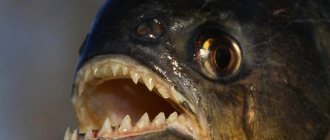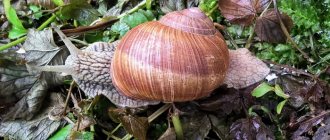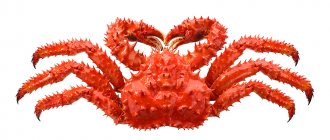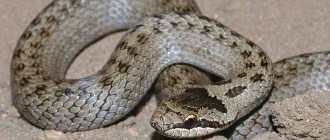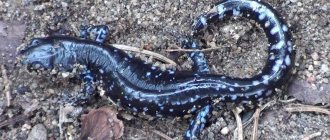An aquarium is a scaled-down model of a hydroecosystem in which fish, plants, snails and other organisms live and interact. The hermit crab will help maintain biological balance in the aquatic environment. It brings great benefits by cleaning aquarium plants from mucus and eating up leftover food for fish. In addition, this animal is interesting to watch.
Description and types of hermits
The hermit crab is a phylum of arthropods in the animal kingdom. 450 species of these crustaceans have been classified and described in detail in the scientific literature.
The most common among them:
- Caribbean hermit crab. It lives near the coast of Venezuela, Florida, and the Bahamas in thickets of mangrove trees. Selects places where sea water is highly diluted with fresh water. The shell is colored red and brown. The claws are purple. Communicates with other individuals through crackling and chirping. In captivity it can live up to 30 years.
- Blue-legged hermit crab. It got its name because of the blue-black color of its legs. It lives off the coast of Australia, on the Hawaiian Islands, and is found both in shallow water and at great depths near coral reefs. The claws are brown.
- Diogenes hermit crab. The name of the species is given by analogy with the ancient Greek philosopher Diogenes, who lived in a barrel. It is found in the intertidal zones of tropical and subtropical ocean waters. The forelimbs (walking limbs) are often striped, colored in green, blue, lilac, and orange tones.
1.Caribbean 2.Blue-footed 3.Diogenous
Maintenance and care
For a comfortable life, a crayfish needs an aquarium measuring 40-80 liters (for small species) and 70-150 liters (for large species). To live well, these creatures need stable air humidity and the right temperature. So, in an aquarium the humidity should be from 70 to 85% at a temperature of 24-30 degrees. Remember that humidity is the most important indicator for crayfish, because they breathe through gills and at low levels they can get sick or die a painful death.
Reptile moss, which can be found at any pet store, works well to maintain moisture. Plus, crayfish will be able to eat it. You can also use special sponges, but they quickly become dirty and need to be changed every 2-3 weeks. Do not forget that they need a special substrate. Very fine sand will best perform its role, because any other filler can scratch the fragile body of the animal. You can replace it with compressed coconut fiber.
Among other things, crayfish love to play and climb. Therefore, their house needs to be equipped with natural stones or other toys. Cancers need to be provided with access to salty sea and fresh water. It is best to install two special containers for this, which the animals can use independently.
From the video “Hermit Crab in an Aquarium” you will learn a lot of useful information.
Structure and characteristics of crayfish
When describing the structure of a hermit crab, the following are distinguished:
- cephalothorax;
- claws;
- torso;
- legs;
- mustache.
These crustaceans differ in size: there are dwarf individuals, no more than 3 cm long, and giant ones - about 15 cm. The right claw serves to protect the entrance to the shell, therefore it is longer than the left one, which is used for obtaining food.
The front part of the body is covered with a hard chitinous shell, the back is soft, always hidden in the shell. The legs located next to the claws are responsible for movement, the small hind legs are hidden in the shell and hold the animal’s body in the “house”.
About life in nature
Hermit crabs are justifiably considered to be travelers in shallow sea waters, because with their dorsal house, they travel over rocks and sand in search of food (food for the arthropod is leftover food of organic origin and small algae), sometimes moving quite long distances. If you encounter a mollusk shell on your way, you can be sure that a crayfish that is already familiar to you will appear from it: at a minimum, legs and eyes, and sometimes several specific antennae, acting as organs of smell and touch, will peek out from its shelter.
In addition to mollusk shells, in natural conditions hermits can settle in the “houses” of gibullus, rapans, nassa and cerithium, and many crustaceans that occupy the shells of rapans often reach unusually large sizes.
Important! In most cases, the claws of a hermit crab are large in size, and it is based on this indicator that they choose the size of the shells (then the entrance to it is blocked by the claw for greater safety: with this placement, it is almost impossible to pull out the animal).
The lack of their own permanent shell makes arthropods easy prey for numerous predators, which is why the animals have no choice but to constantly seek shelter.
The reason for changing its place of residence can only be its limited space, when the crustacean simply grows out of its previous shell.
Lifestyle of a hermit crab
In its natural environment, the hermit crab has many enemies - squids, octopuses, and mollusks. A solid shell house does not provide complete protection. For the sake of safety, many individuals enter into symbiosis with sea anemones, dragging both the shell and their neighbors with them.
The crustacean is constantly growing and is forced to periodically change its shell. It is necessary to borrow a protective shell from gastropods; in the absence of a suitable dwelling, any capacious hollow objects are used.
Hermit crabs exchange houses by tapping on their favorite shell. If consent to move is received, the individuals pat each other on the claws, and the previous occupant leaves the shell. Refusing the exchange, the animal hides deeper or takes a threatening pose. Forced “eviction” of a weaker animal is practiced.
The crustacean spends its entire life on the move, looking for food. They eat algae, pieces of dead fish and shellfish, fruits, and coconuts.
Internal structure
Digestive system
The digestive system begins with the mouth, then food enters the pharynx, short esophagus and stomach. The stomach is divided into two sections - chewing and filtration. On the dorsal and lateral walls of the chewing region there are three powerful chitinous chewing plates impregnated with lime with serrated free edges. In the straining section, two plates with hairs act like a filter through which only highly crushed food passes. Large particles of food are retained and returned to the first section, while small particles enter the intestines.
Next, the food enters the midgut, where the ducts of the large digestive gland open.
Under the influence of secreted enzymes, food is digested and absorbed through the walls of the midgut and gland (it is called the liver, but its secretion breaks down not only fats, but also proteins and carbohydrates). Undigested remains enter the hindgut and are excreted through the anus on the caudal blade.
Circulatory system
In cancer, the body cavity is mixed; not blood circulates in the vessels and intercellular cavities, but a colorless or greenish liquid - hemolymph. It performs the same functions as blood in animals with a closed circulatory system.
On the dorsal side of the cephalothorax, under the shield, there is a pentagonal heart, from which blood vessels extend. The vessels open into the body cavity, where the blood gives oxygen and nutrients to tissues and organs, and takes away waste products and carbon dioxide. Then the hemolymph travels through the vessels to the gills, and from there to the heart.
Respiratory system
The respiratory organs of crayfish are the gills. They contain blood capillaries and gas exchange occurs. The gills have the appearance of thin feathery outgrowths and are located on the processes of the jaws and walking legs. In the cephalothorax, the gills lie in a special cavity.
The movement of water in this cavity is carried out due to rapid vibrations of special processes of the second pair of lower jaws), and up to 200 flapping movements are made in 1 minute.) Gas exchange occurs through the thin membrane of the gills. Oxygen-enriched blood is directed through the gill-heart valves into the pericardial sac, from where it enters the heart cavity through special openings.
Nervous system
The nervous system consists of a paired suprapharyngeal ganglion (brain), subpharyngeal ganglion, ventral nerve cord and nerves extending from the central nervous system.
From the brain, nerves go to the antennae and eyes. From the first node of the abdominal nerve chain (subpharyngeal node) - to the oral organs, from the next thoracic and abdominal nodes of the chain - respectively to the thoracic and abdominal limbs and internal organs.
Sense organs
Both pairs of antennae have receptors: tactile, chemical sense, balance. Each eye contains more than 3,000 ocelli, or facets, separated from each other by thin layers of pigment. The photosensitive part of each facet perceives only a narrow beam of rays perpendicular to its surface. The whole image is made up of many small partial images (like a mosaic image in art, which is why arthropods are said to have mosaic vision).
The balance organs are a depression in the main segment of the short antennae, where a grain of sand is placed. The grain of sand presses on the surrounding thin sensitive hairs, which helps the cancer to assess the position of its body in space.
Excretory system
The excretory organs are represented by a pair of green glands located in the front of the cephalothorax (at the base of the long antennae and open outward). Each gland consists of two sections - the gland itself and the bladder.
Harmful waste products formed during the metabolic process accumulate in the bladder and are discharged out through the excretory canal through the excretory pore. The excretory gland, by its origin, is nothing more than a modified metanephridium. It begins with a small coelomic sac (in general, harmful metabolic products come from all organs of the body), from which a winding tube extends - the glandular canal.
Keeping in an aquarium
The common hermit crab is unpretentious and thrives in artificial reservoirs. The aquarium must have toys that will be comfortable for your pet to climb on. Pebbles, shells, plant branches and artificial algae are suitable.
The size of the aquarium is selected depending on the expected number of inhabitants. For 2-4 individuals, 40-60 liters will be enough. The optimal water temperature is +24...+30 ºC, acidity - 8 pH, salinity - 35-37. It is good to use moss as additional food.
Fine sand is poured onto the bottom of the tank to avoid injury to the animal. The thickness of the layer should exceed the height of the largest crayfish in the aquarium by about 5 times.
This will allow the small arthropod to easily burrow and hide, and create caves during molting. The aquarium should have empty shells of different sizes so that the hermit crab can choose a new home.
The lifespan of an individual in an artificial ecosystem with proper care is about 30 years.
Selecting a suitable home
First of all, you should think about where your pet will live. A glass aquarium would be an ideal option. To select the required volume, it is important to decide at the initial stage how many hermits you plan to settle there. Look at the photo and find out the size. At the beginning, count 1 cm of crayfish per 1.5 liters. In order to determine the size of the cancer, you need to carefully measure the inner diameter of the shell with a ruler. Don't forget to provide space for three dishes, toys and various shelters, as well as a free place where the crayfish can walk freely. As in situations with fish, it is important to monitor the number of inhabitants, but a lack of fish will also not help. If you roughly imagine your future crayfish nursery, then 5-6 small crayfish will comfortably live in a 40-liter aquarium. If possible, immediately purchase an aquarium for growth. The wider the pet house, the more different types of entertainment you can build there. Photos of various attractions can be found on the Internet. Buying a 40-liter aquarium will inevitably entail additional expenses as your pets grow.
Don't ignore the advice about having a lid. The hermit crab is an escape artist. If you forget to cover the tank for even 10 minutes, you can be sure that the next time you will spend hunting for the fugitive. A glass lid with ventilation holes is the best protection against the endless search for escaped crayfish.
Diet and feeding habits
The hermit crab is omnivorous, feeding on any pasture. When keeping a pet in an aquarium, the pet's menu includes meat fillet, krill, shrimp, algae, fish (whole or just the head).
For variety, it is good to use fruits - apples, grapes, pineapples, strawberries, bananas. Coconut flakes, boiled eggs and shells will do. It is not recommended to give crustaceans onions and garlic.
Proper water is the key to health
The only problem in keeping crayfish optimally is the selection of water. The fact is that ordinary chlorinated tap water burns the gills and leads to the painful death of pets. It is important to use purified water for both drinking and hydration. Purchase several bottles of clean water from a pet store. Don't forget about the aqua conditioner. The usual biological film is not suitable for this purpose; it can only be used for bathing crayfish and for keeping fish. It is necessary to find an air conditioner that will remove chlorine from the water and neutralize metals.
Crayfish use two types of water: fresh and salt. If everything is clear with fresh water, then salted water must be prepared at the rate of 10 tablespoons of aquarium salt per 1 batch of water. Wait 12 hours until the salts are completely dissolved and let the crayfish enjoy. The humidity of the aquarium should be between 79-89 percent.
Reproduction at home
At home, hermit crustaceans cannot reproduce. In their natural habitat, the process of emergence of new individuals is year-round. Before mating, crayfish leave their shells. A young female lays 800-1200 eggs, an adult - up to 50,000.
Initially, future crustaceans have a red-brown color, gradually acquiring a grayish or bluish tint. The eggs are incubated on the abdomen for a week, then the female uses her fifth pair of legs to detach them from herself, sending them to swim.
Hermit crab caviar
Reproduction and lifespan
Spring and summer are periods of competition between males for females, who play the main role in the reproductive process. They produce eggs and carry future offspring (up to 15,000 individuals) on their abdomen. Within a week, larvae are formed, ready for independent life in water.
There are four stages of molting, during which young hermit crabs are formed and settle to the bottom. The main task of the juveniles is to quickly find a shelter-shell before they become food for aquatic predators.
Not everyone survives to the settlement stage. Many larvae die at the maturation stage. In nature, the reproduction process of crustaceans is year-round. In captivity, hermits do not bear offspring. The lifespan of a fully formed crustacean is 10-11 years.
Neighborhood with other species
Many hermit crustaceans enter into symbiosis with anemones (sea anemones). The proximity turns out to be beneficial: the arthropod receives protection from enemies and food killed by the stinging cells of the sea anemone (poisoning does not threaten cancer, immunity is developed to the poison), in return the anemone travels on the shell and feeds on the remains of the food of its “carrier”.
The hermit crab shows concern for its neighbor when replacing its shell. The protector sea anemone is carefully transferred to a new “home” or placed on the back of the arthropod until the search for a suitable home is completed. If there are several anemones on the shell, they try to balance themselves and grow stable platforms.
The third participant in the symbiosis is often a polychaete worm. He cleans the inside of the shell, receiving food in return.
Hermit crabs live in groups. There is no need to look for a new sink; you can always use your neighbor’s house. It’s easier to defend against enemies in a group; everyone has a poisonous sea anemone on their back. When searching for food, it is enough for one person to find edible pieces, and neighbors are immediately notified of the presence of food.
Hermit crabs do not tolerate loneliness well, so it is necessary to place several individuals in the aquarium. The neighborhood with other inhabitants will be calm; arthropods are not interested in live fish. Only snails are in some danger: their shells can be appropriated as housing, and the former inhabitant can be eaten.
Natural enemies
At the larval stage, the hermit crab often becomes prey for other marine life. An adult hermit crab, thanks to its “house,” has fewer enemies. The most dangerous moment in the life of cancer is moving to a new “apartment”. During this period, his soft body is not protected by anything, so the hermit can become easy prey for any large animal.
During the breeding season, when cancer is looking for a new home, it can be very restless. Sometimes a hermit crab kicks its weaker relative out of its shell and appropriates it for itself. Even with a house on its back, a hermit crab does not feel completely safe. Its main enemies are cephalopods, octopuses and squids, which with their strong jaws can crush the protective shell of a hermit crab in a second.
Interesting Facts
Interesting Facts:
- Instead of a shell, a hermit crab can use hollow objects - lids, parts of bottles, cups, glasses.
- Some types of crustaceans do not live in shells.
- If, when danger arises, an individual hangs from its shell, it means that it will soon die. A healthy animal will first hide in the house, and then begin to poke its eyes and antennae out of it.
- Cancer has good hearing; sharp sounds can frighten him.
- Determining whether a pet has died is easy. A living arthropod will offer resistance when any of its limbs are flexed.
- To breathe, the crustacean uses gills, extracting dissolved oxygen from the water.
Hermit crabs are a useful decoration for an aquarium: they will bring pleasure to their owners and clean the artificial pond of cyanobacteria and detritus.
Next
CrustaceansShrimp red crystal. A young popular species for experienced aquarists
Perfect lining
Creating a lining not only decorates the aquarium, but also has practical value. The substrate must have a thickness of at least 15 centimeters or the height of the largest individual multiplied by two. For small crayfish, 12.5 is enough, and for a brood, 10. These numbers indicate the optimal depth for molting. Sand is considered the best available substrate. If possible, purchase compressed coconut fiber. To save money, you can mix these two types of soil. Pay attention to maintaining humidity. It is important that both the sand and the coconut fiber are slightly damp. Constant humidification and a glass lid will help achieve this effect. Thanks to this microclimate, crayfish quickly grow in size and develop fully.
Feeding
There are no problems with feeding crayfish. The fact is that hermit crabs calmly feed on any type of food, since in their natural environment they consume any available food. They will be happy to eat leftovers from your table, canned food. They will not give up fruits and seafood, which are very important for maintaining optimal levels of vitamins. Feed them meat, cereals, groceries and rolled oats. If you didn’t cook anything today, the crayfish will gobble up the specialized food. It’s true that crayfish don’t eat much, so give the food in small batches and see how they react to it.


